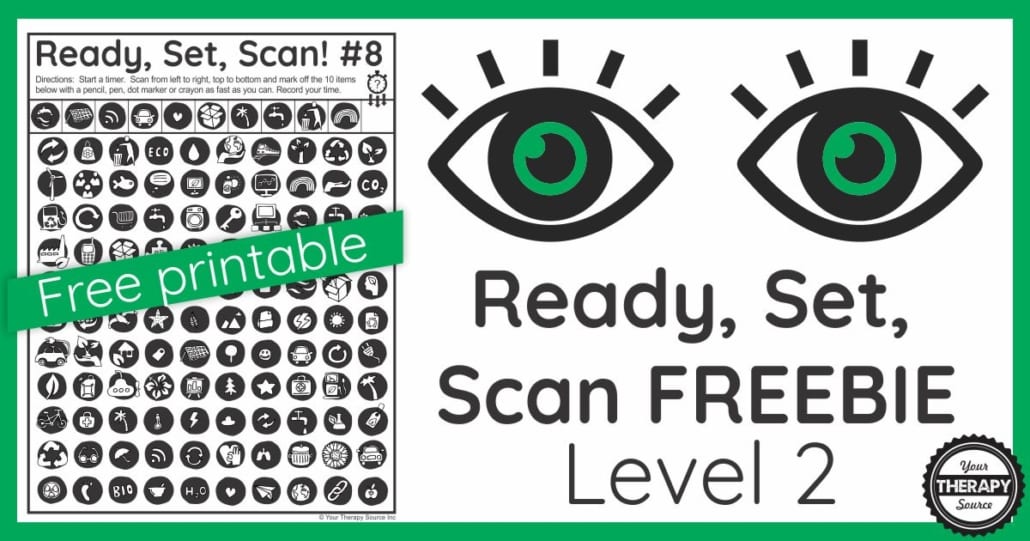Visual Scanning Activities – Free printables and Ideas

Visual scanning is basically the ability to find and search for information in your environment. The information could be letters on a page, headlines, people, or objects. Children need to search and compare what they are looking for as they scan the environment at school, and home. By practicing visual scanning activities, children may become more efficient and quick at finding the information that is necessary for different tasks.
An example of visual scanning is looking for someone in a crowd, searching for a matching sock in a pile of laundry, or locating a vocabulary term in a textbook.
You can download some FREE visual scanning worksheets for occupational therapy sessions, vision therapy, or just for fun at the bottom of this post.
Visual Scanning Activities Can Be Fun
Children love novelty and to play games. Working on visual scanning activities can be fun and entertaining! Here are 5 suggestions:

- Download a FREE printable at the end of this post to challenge visual scanning skills. The children have to scan and find 10 different objects as quick as possible. This freebie is from Ready, Set, Scan Level 2.
- Play “I Spy” with extra clues. Ask the children to scan the room for very specific objects and see who can find it first. This adds in executive functioning skills as well. For example, ask the children to visual scan and find a black object that helps hold paper together. The children can scan the classroom to find and point to the stapler.
- Complete letter finds, word finds or hidden pictures puzzles to visually scan and find objects on a page. For younger children, Find and Follow is fun! For older children, check out One of a Kind.
- Play Hide and Seek with Toys. One player takes a small toy and hides it in another room where at least part of the toy is showing. The other player(s) then go into the room and see who can visually scan and find the object first. They both have to stand in the same spot in the room.
- Have a scavenger hunt in a book. Grab any random book. Call out words that are used often such as the, and, said, who, etc. The child has to find the word you call out in the book as quick as possible.
WHAT IS VISUAL SCANNING?
The definition of visual scanning is the ability to quickly and accurately search text, an area, or scene for relevant information.
This is a complex skill. Visual scanning is the process of observing and absorbing information from a printed page or computer screen by looking at each word, line, and paragraph in turn. On its own, it does not sound like much, but for many students this simple skill can hold them back from reaching their full academic potential.
Visual scanning is such a fundamental aspect of literacy that most people take it for granted, meaning that it has been largely overlooked as a key factor in reading difficulty. However, despite its relative simplicity, there is evidence to show that poor visual scanning skills can result in students experiencing significant difficulties with their literacy learning (Ferretti et al, 2008).

The Visual Perceptual Packet
WHAT ARE SOME SIGNS OF POOR VISUAL SCANNING SKILLS?
Some examples of poor visual-scanning skills are:
- Unable to find objects in a crowded area
- Decreased ability to find things around the house
- Unable to recognize words or letters quickly – the inability to recognize words and letters can lead to difficulties with reading comprehension, spelling and vocabulary acquisition.
- Poor paragraph comprehension – the inability to understand written information spread across several pages. This can result in students having difficulty with essay writing, book reports and general research.
- Poor proofreading skills – the inability to accurately identify errors. This can lead to all types of writing-related difficulties such as poor punctuation, incorrect grammar and incorrect spelling.
WHAT IS THE DIFFERENCE BETWEEN VISUAL SCANNING AND TRACKING?
Visual tracking is the ability to follow a series of different images with your eyes, without losing track. Tracking skills allow you to move your gaze from one object to another and helps you avoid tripping or bumping into things when walking around.
Tracking is the ability to smoothly shift eye gaze from one point in space (the center) and smoothly follow moving objects. When you are tracking objects, your eyes will automatically make small saccades (tiny movements) to help move the object of interest to your fovea (the center part of the retina).
When people catch up with written text as they read, it is because they have developed tracking skills. If you were unable to track and maintain your gaze on a single point, you would not be able to read.
Visual Scanning is just one part of tracking skills – it involves being able to organize information from different parts of the visual field into a whole. It also means that the eyes are working together so that both eyes send their images through the brain at the same time.
WHAT ARE SOME RISK FACTORS FOR VISUAL SCANNING PROBLEMS?
There are a number of reasons why a student may have problems with visual scanning.
A lack of exposure to print – where a child has not been exposed to enough words printed on paper, they will struggle to learn how written language works and so will experience difficulties with decoding and encoding words.
Poor vocabulary – a lack of understanding of how words work limits a child’s ability to identify the words they are looking at. This leads to slow and inaccurate word recognition, which in turn leads to problems with decoding and encoding words.
Decreased phonemic awareness – where children struggle to make connections between how letters represent sounds, making the connection to recognize words and letters can be difficult.
Attention difficulties – where a child experiences problems with attending to and completing tasks, they can find it hard to engage their visual scanning skills in a meaningful way.
HOW DO YOU TEACH VISUAL SCANNING?
As a parent or teacher, there are many things that you can do to support your child in learning how to scan properly. Below are some tips that may be helpful:
Teach your child to recognize the first letter of words quickly – once they recognize the first letter, they are able to recognize what word it is
Develop phonemic awareness – many reading difficulties stem from a lack of phonemic awareness (understanding that words are made up of sounds or speech sounds). You can help develop your child’s phonemic awareness by using a variety of activities such as making up rhyming word games.
Teach them the parts of a word – discuss with your child what letters make up each part of the word, for example: ‘in’ is made up of an ‘i’ and a ‘n’.
Help your child figure out the whole words – by teaching them to recognize the parts of the word, they will find it easier to work out what words are.
Teach your child that spaces between words help them break up words into smaller pieces – this makes recognition much easier.
Develop pattern awareness – show your child how some words follow patterns (like ‘op’ for cup, pop, shop etc.)
Find games and activities to support your child’s visual scanning – there are many games and exercises available that may be helpful in developing a child’s scanning skills.
Make reading an enjoyable experience – use reading time as a way of encouraging your child to read more often with you!
HOW ARE VISUAL SCANNING PROBLEMS TREATED?
There are many different therapies that can be used to help improve visual scanning skills. Occupational therapists, physical therapists, vision therapists, and teachers may all treat visual-processing problems differently, so it’s important to find the right person for your child.
The key is finding out what part of the process is causing the problems for your child, and then finding the right way to support them.
As a parent, you can help your child by providing plenty of opportunities to learn how to scan both at home and in school. Many children with visual scanning problems find it difficult to concentrate in the classroom because they are constantly bombarded with visual distractions, so make sure that there are many opportunities to practice as possible.
It’s also important to try and find fun ways to support your child in practicing visual scanning throughout activities of daily living too. One example would be to increase exposure to reading by writing words on signs and labels around the room. Another example would be to practice when scanning for the toothbrush on the counter or the white socks in a dresser drawer. Visual scanning is not just about reading.
Just remember – if you think there is a chance that your child may have some sort of visual processing problem, the more you know about it, the easier it will be to find ways to help them.
IF YOU HAVE CONCERNS… seek help. Early intervention is key! The earlier you can identify a possible issue and determine what needs to be done, the better it may be for your child. It’s important to remember that many children with visual-processing problems are bright kids who just need help developing certain skills. You may want to seek out a full assessment by an occupational therapist or vision therapist in your area if you feel there is even the slightest chance that your child may have some sort of visual-processing disorder and you want to determine what can be done.
REFERENCE
Ferretti, G., Mazzotti, S., & Brizzolara, D. A. N. I. E. L. A. (2008). Visual scanning and reading ability in normal and dyslexic children. Behavioural Neurology, 19(1-2), 87-92.
Download Your Free Visual Scanning Activities FREE Printable
Sign up to receive the weekly Your Therapy Source email newsletter and announcements. After you enter your email, you will be redirected to the FREE visual scanning activity. If you can not see the sign-up box, send us an email at info@yourtherapysource.com referencing the freebie and we will email it to you.
RELATED RESOURCES
Summer Visual Scanning Activity



